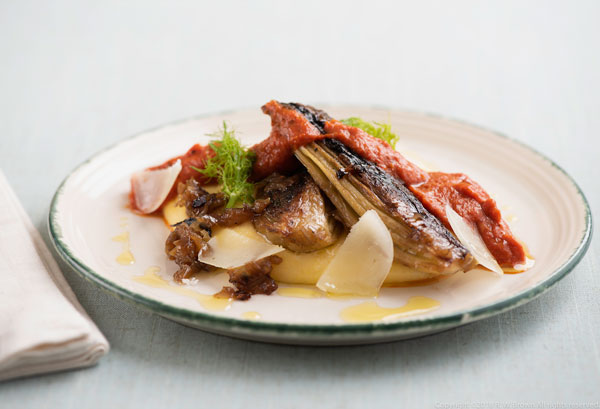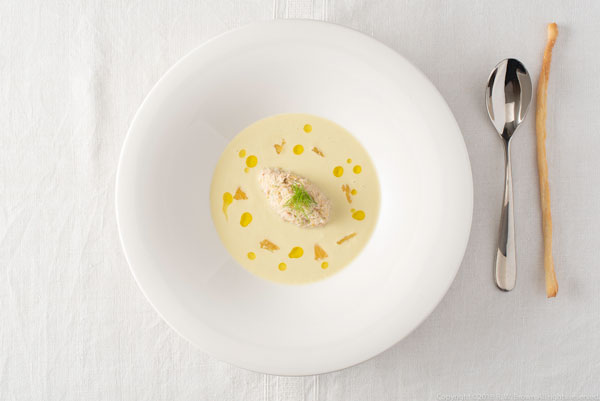Home-grown harvest: Fennel
Love it or hate it, fennel has a distinctive flavour that can add fantastic depth to your dishes. Russell Brown demystifies the divisive bulb
Fennel probably comes under the category of a Marmite vegetable, as the flavour
really does seem to divide opinion.
Aniseed notes in general seem to have this effect; I paired a wine with a rabbit dish and a light liquorice sauce for a wine dinner many years ago; it certainly drew comment and not all of it positive.
The season for fennel grown in the UK runs from August to November. It is another of those vegetables loved by gardeners and is therefore often seen in kitchen gardens. As a commercial crop, there are a number of growers, with one of the major ones being DGM in Holbeach, Lincolnshire. The plants for fennel herb and Florence fennel are different, although the leaf fronds of the Florence
fennel can be used as a herb. The biggest problem with cultivating fennel is its tendency to bolt and go to seed before the bulbs are fully formed. This is generally caused by growing conditions being too dry.
The seeds from fennel have a significant role, particularly in Italian and Indian cooking. In Italy they are regularly used in cured meats, with finocchiona, a fennel salami from Tuscany, perhaps the most famous. In recent years fennel pollen, known as the spice of angels, has seen a resurgence in popularity with most product coming from wild plants.
Calabria in Italy is one place particularly noted for the collection of wild fennel pollen. Florence fennel, also known as finocchio, can be eaten raw, thinly sliced in salads, as well as pickled, steamed, baked, roasted or braised. Gratins, soups and purées are other popular ways to use this vegetable. Although more often used in savoury dishes, fennel does make some appearances in the pastry kitchen.
Because of the way it caramelises, a tatin-style dessert is one option, but it can also be candied and used in cakes or infused in cream for a pannacotta. In French classics such as Larousse, fennel gets scant mention, but pick up an Italian cookery book and it is a different matter. In the section on Florence fennel in Anna Del Conte's Gastronomy of Italy, there are nine fennel recipes mentioned, and in Italian Food by Elizabeth David fennel is mentioned on numerous occasions.
Nathan Eades, head chef at the Wild Rabbit in Kingham, Oxfordshire, minces bulbs of Daylesford Farm fennel and cooks it in fennel juice for a barbecued rabbit dish, while chef Jason Reeves at the Black Swan hotel in Helmsley. York, cooks charred fennel in chicken stock for a dish of cod, crispy cod skin and caviar crackers.
Freelance art director and designer Matt Inwood has worked on many cookery books and recommends spaghetti with roasted fennel, chilli and lemon from the Eagle Cookbook, illustrating that affinity with Italian food once more.
Buying and storage
•Store in the fridge
•Wrap in damp paper towel as the bulbs suffer from dehydration
•Bulbs should feel heavy for their size
•Bulbs should feel solid when pressed
Caramelised fennel with roasted pepper and chilli dressing, soft polenta and Pecorino
Serves 8 as a light main course
For the polenta
900ml water
1 large clove of garlic
9g Maldon sea salt
225g polenta
70g butter
70g Parmesan
For the fennel
4 large bulbs fennel
50ml olive oil
3 banana shallots, sliced in ½cm rings
100ml white wine
200ml fresh vegetable stock
Maldon sea salt and freshly ground black pepper
For the dressing
2 Romano red peppers
2 chillis
2 banana shallots, sliced
2 cloves garlic, sliced
50ml olive oil
100ml tomato passata
Sherry vinegar
Maldon sea salt and freshly ground black pepper
50ml good quality extra virgin olive oil
To serve
Pecorino shavings
Extra virgin olive oil
To make the polenta, place water, garlic and salt in a Thermomix, set at 90°C, process speed six for five minutes. Then set to speed one and drizzle in the polenta. Change to the butterfly whisk and cook at 90°C for an hour, speed two.
Add the butter and Parmesan and mix at speed two for two minutes at 90°C. Check and adjust the seasoning. Alternatively, make in a pan in a similar
way; however, you may need to add more water.
Peel the tough outer layer from the fennel and trim the tops. Cut each bulb into four wedges and trim out the core, leaving enough to hold the wedges together. Season on both sides.
Heat the olive oil in a heavy non-stick pan and add the fennel, caramelising well on the cut surfaces. Add the shallots to the pan and cook for five minutes.
Add the white wine and reduce. Pour in the vegetable stock and cover with baking parchment. Transfer to a medium to hot oven and cook for around 15-20 minutes until the fennel is nearly tender. Remove the parchment and reduce
the liquid completely to glaze the fennel.
For the dressing, char the peppers and chilli to remove the skins. De-seed and roughly chop. In a small roasting tin, mix the peppers, chilli, shallots and garlic
with the olive oil and roast at 170°C, turning occasionally until all the veg is lightly charred, for approximately 15-20 minutes.
Blitz the pepper mix with the passata. Season with the vinegar, salt and pepper. Finish with the extra virgin olive oil. To serve, spoon the hot polenta into shallow bowls and place two fennel wedges in each bowl. Add a generous spoonful of the pepper sauce and scatter over Pecorino shavings. Finish with some good olive oil.
Chilled fennel and orange soup with white crab
For the soup
(approx 15 portions)
50ml olive oil
2 medium bulbs fennel, trimmed and diced
1 stick celery, sliced
1 small leek, sliced
2 cloves garlic, crushed
1 large orange
50ml Pernod
1 star anise
1l vegetable stock
200ml double cream
Maldon sea salt and freshly ground black pepper
For the crab mix
(four portions)
4 orange segments
100g picked white crab meat
1tsp chopped fennel fronds
20g mayonnaise
Maldon sea salt and freshly ground black pepper
To serve
Extra virgin olive oil
Grissini sticks
A few small pieces of orange
Heat the olive oil in a medium saucepan and add all the chopped vegetables and the crushed garlic.
Season with a little salt and sweat gently until tender, for approximately 10 to 15 minutes.
Grate in the zest from the orange and then add the segments. Add the Pernod and flame. Add the star anise and vegetable stock and simmer for 10-15 minutes to reduce by a third.
Remove the star anise, pour in the cream and then transfer the contents of the pan to a blender. Blitz until completely smooth and pass into a clean pan. Reduce if necessary and season to taste, adding more orange zest if required.
For the crab mix, break up the orange segments and then mix in the remaining ingredients, seasoning to taste.
To serve, quenelle the crab mix and place in shallow bowls. Pour the chilled soup around and drizzle on some good olive oil. Add a few small pieces of orange and serve grissini sticks on the side.
Continue reading
You need to be a premium member to view this. Subscribe from just 99p per week.
Already subscribed? Log In







